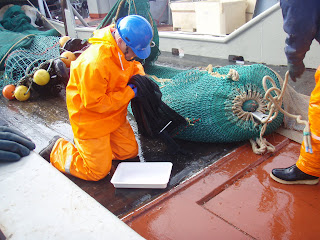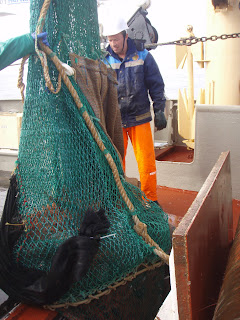Going along on this survey has given me an idea of the massive amount of information about the fisheries that MRI collects to assess the populations of the important species in Icelandic waters. The shrimp survey has been carried out regularly beginning in 1973 (the same time that Iceland evicted foreign fishing fleets from its waters by extending its national jurisdiction to 200 miles), even earlier than the groundfish survey, which began in 1985. Systematic study of Iceland’s fisheries, though, began as early as 1908, when Bjarni Saemundson (this research vessel’s namesake) began studying the commercially important species.
The survey procedure is pretty straightforward: there are a number of pre-determined sites that the survey goes to year after year, and at each site the trawl is set and pulled over two nautical miles in an hour. The net is then pulled back in, the catch is dumped out to be measured, and then the ship goes to the next site to start over again. Although two weeks of sampling at over eighty trawl sites seems like a lot of data to collect, this survey actually used to be much larger and take six weeks. But as both the shrimp population and the prices for shrimp have decreased over the past few years, funding for studying the shrimp has decreased. In addition to providing a lot of information about shrimp, the survey also collects information about all the other species that get caught in the net, and since the net used to trawl for shrimp has a fairly small mesh size, it catches quite a variety of species which would not be studied at all without this survey.
So here’s how the basic procedure works:
After the hour of trawling is up, the net is pulled in by a series of very large winches attached to tow cables (and a good thing this is a very high-tech modern ship – you wouldn’t want to be hauling this up with an old-fashioned windlass). The crew is very efficient and goes through the same procedure of detaching and reattaching ropes and cables at different parts of the net to fold it up on the deck until the cod end of the net has been fully pulled up.
Detaching the cable from the otter board that holds the net open while trawling:
Attaching a rope to finish pulling in the net:
Seagulls have followed the ship the whole way, and get particularly excited when the net full of shrimp and fish is pulled in. In Iceland, the seagulls are known as the fisherman’s friend because they follow the fishing boats.
Before the main net is emptied, one of the scientists on watch (there are two watches each with three scientists) opens a bag on the side of the net with a smaller mesh size that collects the juveniles that would otherwise get through the main net. This juvenile bag is important because it gives an idea of the size of the newest year-classes, giving MRI the necessary data to predict how large the population will be in a few years and recommend quotas accordingly.
Here's one of the scientists emptying the juvenile bag:
The main net is then opened and emptied into a hatch where the fish and shrimp come out in a processing room below the deck.
Here's the full net being emptied above deck:
And here everything comes out below:
The next step is to sort the catch, which has all sorts of marine creatures: octopi, jellyfish, seastars, large spotted catfish, haddock, cod, redfish, Greenland halibut, capelin, and many other fish along with, of course, a lot of shrimp. Each species is measured – for small species like capelin, only a few measured by length and the rest are just counted. For larger species like cod, they record their length and weight, and for most also cut open the head to remove the otoliths for ageing the fish and open the guts to weigh the liver and empty out the stomach to analyze its contents.
Stomach contents in a sieve for analysis:
Since I have almost no background in biology, and certainly in fisheries biology, I mainly help with simple tasks like sorting the fish by species and counting hundreds of the small fishes like capelin. It’s not really a gloriously exciting task, but it gives me a chance to learn to identify the major species (and learning names in both Icelandic and English, both by asking a lot of questions and looking through the nicely illustrated book about all the Icelandic fish). It’s probably also best that I’m not cutting open the fish because not only would I be infinitely slower than everyone here with years of experience, I’m a little soft about this whole concept of killing lots of fish…there’s something very sad about watching them flop around and gulp with their mouths and gills. I know this is what fisheries are all about I don’t have any Greenpeace-style opposition to killing fish, it’s just unsettling to watch (which, slight tangent: as we were leaving the harbor in Reykjavík, Ludvic pointed out some of Iceland’s whaling ships that had been there since the whaling ban was put in place and told me that there used to be more before Greenpeace sank them right in the harbor).
For the shrimp, a random subsample – at least 200 from each trawl – is separated to analyze more specifically and the rest is separated from the fish and weighed to determine the total amount in the catch. Some tows collect a lot of shrimp – sometimes over 300 kilos.
Each of these buckets can hold over 20kg of shrimp:
Although I hadn’t thought much about shrimp before, shrimp biology – or at least specifically for the major species found in Iceland, Pandalus borealis – is fascinating. They are all born as males and after a few years transition to females and begin to bear eggs. Since there’s no easy way to determine the shrimps’ age the way fish can be aged using the otoliths, they record their size and sexual stage. The size is measured based on the length of the hard carapace, using calipers that are accurate to the half-millimeter. Sexual stage is determined both by checking whether it is male or female (or in a transition state – I think the transgender movement could do interesting things with occurence of this kind of gradation of sexual identity in nature), whether the females have laid eggs before (if they haven’t they have small spines in their undersides), and where they are in the process of currently laying eggs – at first, they become “green in the head” as the eggs begin to develop, then move to the clutch on the underside as a collection of green eggs, and finally grow eyes after a few months.
Measuring and recording data on each shrimp in the sample:
Although this isn’t an exact age measurement, you can see peaks for each of the young age classes in the smaller shrimp, although the trends become less distinct when they reach sexual maturity and start putting most of their energy into reproduction.
Here they all are measured and lined up before being counted:
At the end of two weeks, once we’ve sampled all across the waters of northern Iceland, all this data – both on the shrimp and the other species – will be added to decades of data on these same sites and used in the population calculations and quota recommendations that MRI makes annually. We haven’t seen many juveniles as apparently they would ideally like – Skuli says it’s probably because the cod aren’t getting enough capelin, so they’re eating the shrimp instead – but it seems like the shrimp stock is doing better than last year, so hopefully last year was the worst and now things will be improving. This is probably also closely related to the decline in the cod stocks, with the reduced population of cod (particularly the juvenile cod, which are more inclined to eat small crustaceans than the large cod, which prefer to eat fish) allowing the shrimp to do better.
I can see, just watching what we’ve caught, why fishermen would be upset at the cut in the cod quota: we’ve seen many large cod, some over a meter long and over ten kilograms, which makes it seem like there are plenty available to be caught, but we didn’t see any juveniles during the first week and still too few later on. When I talked with Bjorn at MRI about cod ranching, he mentioned that feeding capelin to cod was one way of preserving the stocks of crustaceans they eat, helping the shrimp fishery and also making sure that the cod are well-fed. The problem with something like this, though, is that it’s much more complicated than the simple transferable quota system and I suspect that no company is going to want to risk their money on such a large-scale endeavor.
The huge amount of precise data MRI collects about the fisheries seems to avoid the major problems of overestimation that have caused problems in other places that develop quotas and the Icelandic government has generally listened to MRI’s recommendations, although not always followed them exactly. There are, of course, more difficult questions about the fishery, such as whether there are other methods (such as cod ranching) that would more efficiently use Iceland’s marine resources and whether the country should try to protect and preserve the small fishing towns around the country when quotas are cut. Those are questions I certainly can’t answer, but at least what I can tell from this survey is that the scientific base of knowledge that is used to help with those decisions is comprehensive and taken seriously both by the scientists and by those who make the final policy determinations.













No comments:
Post a Comment